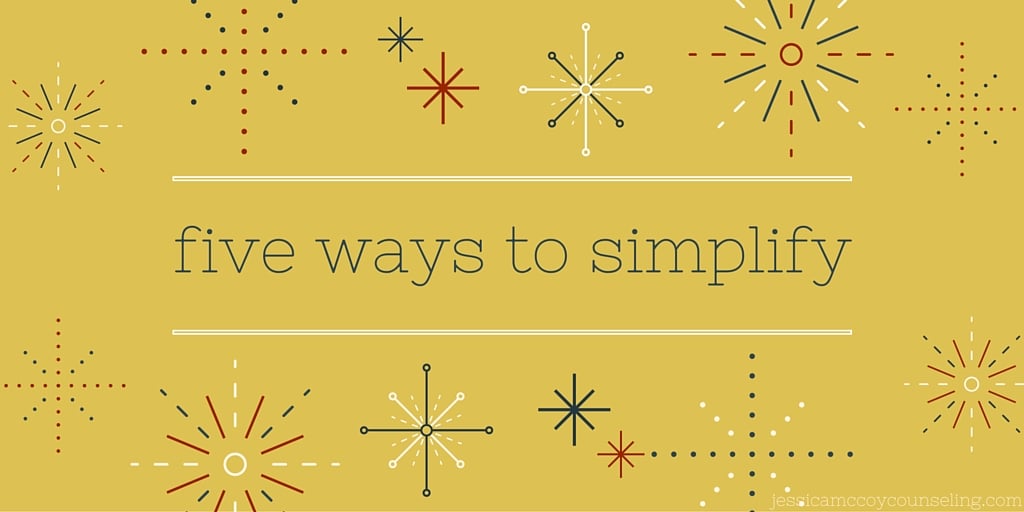Five Ways To Simplify
/At the start of 2016, you may be searching for a new way to make your life easier. Many people often look for a fast and easy way to have a better life. Often they buy into the myth that if they just add one more thing then everything will be great. You hear it on the television and radio. If you just buy this product then you will be more _______________ (beautiful, wanted, successful…). That’s a loud voice in our world.
But I want to offer you another voice today. The thing you are looking for may not be found in adding more things to your life. Instead, the thing you might need most in 2016 is the very opposite. You may need to simplify.
To simplify means to make something easier to do or understand. Simplifying is a practice. It’s a habit that you have to learn over time because removing things is never easier. For that reason the act of simplifying may seem strange, but many people are trying it anyway. And what they are finding is that by decreasing clutter in their lives then they are inviting greater calm into their lives.
Here are five ways to practice simplicity:
Mari Kondo's The Life-Changing Magic of Tidying Up:
This book has become a viral sensation. It is a #1 New York Times bestseller and has inspired thousands of people to re-evaluate (or evaluate for the first time) how they organize, tidy, or let go of possessions. Kondo walks readers through the process of determining what needs to stay and what needs to go. The question that resonated with me was “does this spark joy?” If it does, keep it. If it doesn’t, then pass it along to someone else.
Wardrobe Capsule –
To create a wardrobe capsule you need to determine how many items of clothing you actually need to create your entire wardrobe. Yes, I said, “Actually need.” The goal is to clean out your closet and have a limited number of clothing choices. Check out Pinterest for ideas.
A wardrobe capsule also helps combat Decision Fatigue. Science has shown that people can only make a certain amount of decisions in a day before it begins to wear them down completely. Choosing your outfit, breakfast, and what podcast to listen to are just a few of the decisions that build up through an ordinary day. Using a wardrobe capsule is one easy way to lower the number of decisions you make and give your brain some rest.
Season of "No" –
For many people, the idea of saying no makes them very uncomfortable. There is guilt or fear tied to “what if they think I am selfish?” Or we might even experience a small case of FOMO (Fear of Missing Out). But we have to remember something essential: saying yes to something means saying no to something else.
So if you say “yes” to being on the neighborhood HOA, then you may miss a birthday dinner for your friend. If you say “yes” to a weekend away with your girlfriends, then you may have to say “no” to a family event that same weekend.
Establishing a season of no allows you to determine a period of time when you say “no” to anything extra that comes your way. You decide the boundaries of this season and what it does and does not include. A season of no allows you to simplify your schedule and say “yes” to being present in other surprising ways.
Create a budget –
Money makes the world go round, but it also helps you make choices. Creating a budget allows you to have an informed “yes” or “no” to new purchases or expenses. Unless you love working with numbers, budgeting may be a hard task for you. But it empowers you to be able to take a realistic view of your life and your income.
Create space for margin-
Margin is intentionally “blank space” in your life. Cultivating a schedule with margin allows you to move from a packed calendar to a more balanced life. Maybe this means Saturday morning’s schedule is empty. Maybe it means Tuesday and Thursday evenings are yours to spend however you wish. For some, the spiritual practice of Sabbath creates space for such margin. It is a practice intended to slow your life down because you have faith that someone else is in control.
Each of the above tools is intended to move you towards a healthier way of life. Pick one and see what it does for your next week, month, or even year. If you would like to talk with someone more in depth about how to simplify in your own life, then please contact Jessica today. I am happy to talk with you about possibilities for you to have a healthier 2016.








